Blog

Refinance Pool Grows, but Not Among Sub-620 Credit Scores
The number of homeowners who could potentially benefit fromrnrefinancing has increased by 3 million in the last year according to BlackrnKnight Financial Services’ April MortgagernMonitor. Interest rates have dropped back in recent month while home pricesrnhave continued to rise, growing the pool of borrowers who appear to meetrnbroad-based eligibility criteria for refinancing substantially. </p
Trey Barnes BlackrnKnight’s senior vice president of Loan Data Products, said, “Black Knight looked at the populationrnof borrowers whose current interest rates – as well as credit scores andrnloan-to-value ratios – mark them as good candidates for refinancing. In February 2014, there were approximatelyrn4.1 million borrowers who could both benefit from and potentially qualify forrnrefinancing their mortgages. Through a combination of declining interest ratesrnand increased equity among borrowers driven by home price increases, anrnadditional three million borrowers now meet the same broad-based eligibilityrncriteria as compared to one year prior.” While the number had reached as highrnas 7.4 million in September 2014, as of the end of February 2015, there were arntotal of 7.1 million potential refinance candidates. </p
This however is a very rate sensitive group and a 50 basisrnpoint increase in mortgage interest could wipe out that 3 million borrower gain. In fact Barnes said, it was largely a 60rnbasis point decline in rates that brought those borrowers into the refinanciblernuniverse. </p
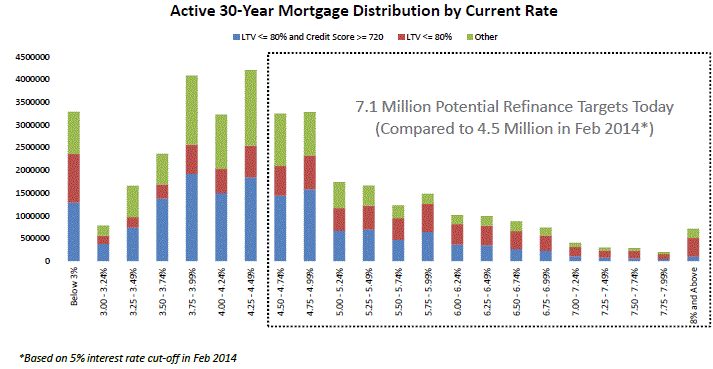 </p
</p
The rate of mortgagernprepayments in recent months seems to indicate that some homeowners arernplanning to take advantage of the current situation. Prepayment speeds, typically an indication ofrnrefinance activity, jumped 31 percent in February as compared to January. They were also 75 percent above levels thernprevious February.</p
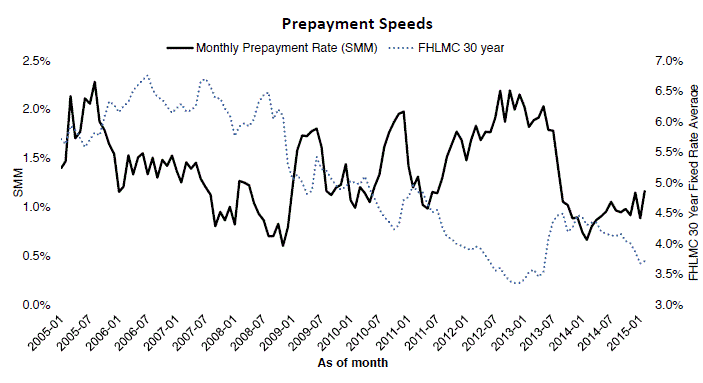 </p
</p
Barnes pointed to another finding from Black Knight’s analysis. “Prepayment speeds of lower credit scorernborrowers – those with scores below 620 – are the lowest we’ve seen sincernstarting to track this data in 2000. As a result, the average loan age for thisrngroup is 98 months, as compared to just 38 months and less for borrowers withrncredit scores of 750 and above.”</p
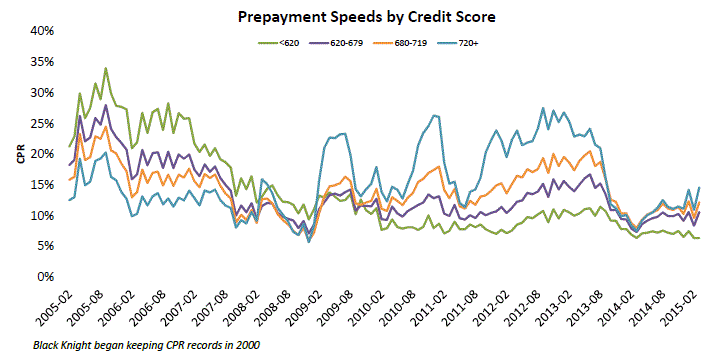 </p
</p
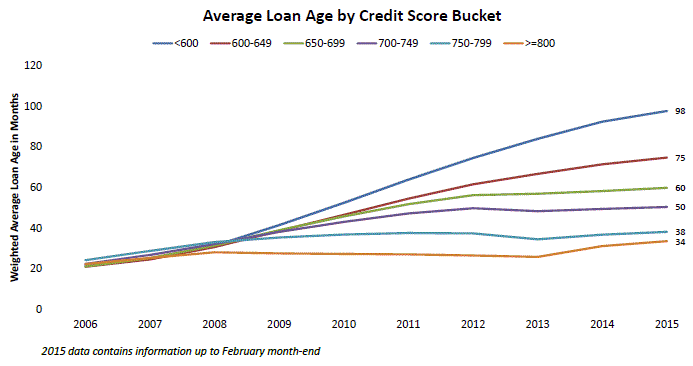 </p
</p
The increased prepaymentrnspeeds also varied among investor categories. rnPrivate label securities showed a monthly increase of prepayment ratesrnof 8.4 percent and a yearly rate of 18.7 percent, much lower than otherrninvestment groups. This, Barnes said, is likely tied to the factrnthat roughly 30 percent of active loans in private label securities have creditrnscores below 620.</p
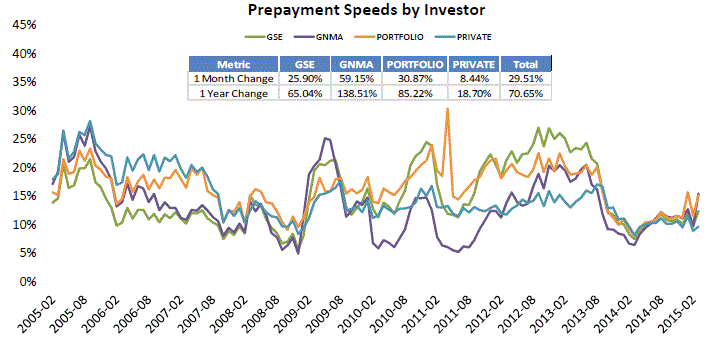 </p
</p
The Monitor also tookrna close up look at 2014 real estate transactions. The analysis found that, even as overall homernsales were down from 2013, traditional market sales were up compared to thatrnyear and at their highest level since 2007. rnThis was due to a decrease in distressed sales, which dropped to theirrnlowest levels since 2007. Nationallyrnonly 12.7 percent of real estate transactions were lender-owned propertiesrn(REO) or short sales, down from 17 percent in 2013 and a peak of 33 percent inrn2011. Short sales were down by 45rnpercent in 2014 while REO sales fell by 16 percent.</p
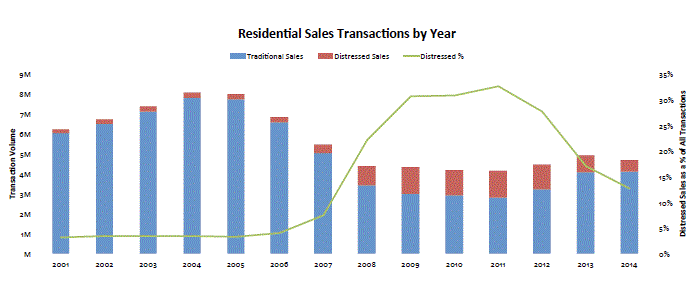 </p
</p
Short sales are currently discounted anrnaverage of 23 percent from market prices (meaning they are selling at $0.77 onrnthe dollar, down from a peak discount of 25.3 percent in July 2013. REO discounts now average 27 percent, thernhighest since the fourth quarter of 2012. rnThese discounts peaked at 29 percent in April 2009</p
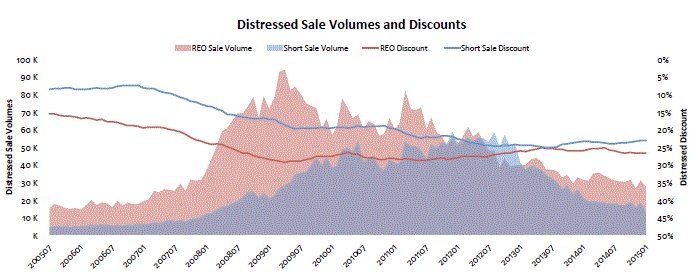 </p
</p
The highest percentage of distressed salesrnin 2014 were in Florida at 25 percent of all transactions in that state. In fact, Florida accounted for 26 percent ofrnall distressed sales in the United States. Florida and three other states with thernlargest share of distressed sales, (California, Illinois, and Michigan)rntogether accounted for over half of all such transactions last year.</p
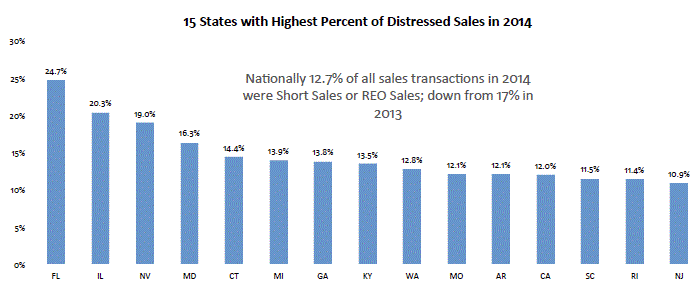 </p
</p
Looking at what Black Knight calls “thernbubble states,” Arizona, California, Florida, and Nevada, those most impactedrnby the housing bubble and its aftermath, Florida’s level of distressed sales isrnimproving at the slowest rate. The otherrnthree have seen a reduction in their share of distressed sales of 79 percent orrnmore from their peaks, Florida has seen only a 54 percent decrease. </p
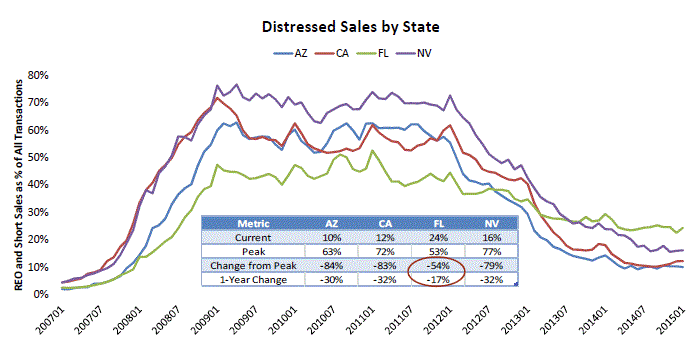 </p
</p
The distressed sale discount in Florida,rnwhile lower than the national average, is also higher than in other bubblernstates, 24.4 percent. The state also hasrnthe highest remaining rate of 90+ day delinquent loans and loans in foreclosurern(6.5 percent) of any bubble state and ranks fourth nationally in this regard behindrnNew Jersey (8.4 percent), New York (6.8 percent) and Mississippi (6.7rnpercent). Florida has also seen thernlowest level of home appreciation of any of the major bubble states since thernmarket hit bottom. Prices there havernrisen 30 percent as compared to 35, 41, and 51 percent for Arizona, California,rnand Nevada respectively.</p
Black Knight points out that, among thernbubble states, Florida is the only one with a judicial foreclosure process.
All Content Copyright © 2003 – 2009 Brown House Media, Inc. All Rights Reserved.nReproduction in any form without permission of MortgageNewsDaily.com is prohibited.
Latest Articles
By John Gittelsohn August 24, 2020, 4:00 AM PDT Some of the largest real estate investors are walking away from Read More...
Late-Stage Delinquencies are SurgingAug 21 2020, 11:59AM Like the report from Black Knight earlier today, the second quarter National Delinquency Survey from the Read More...
Published by the Federal Reserve Bank of San FranciscoIt was recently published by the Federal Reserve Bank of San Francisco, which is about as official as you can Read More...

Comments
Leave a Comment